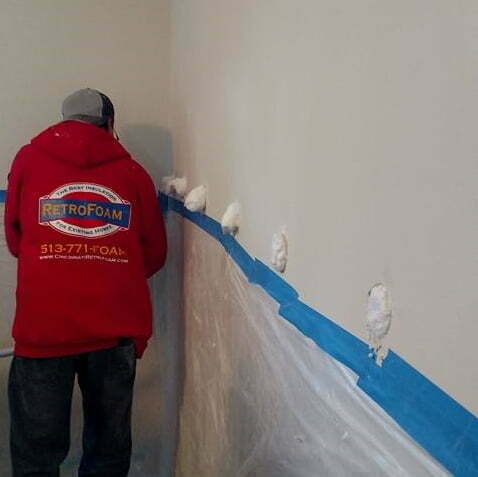If you’re looking to improve the comfort and energy efficiency of your home, injection foam insulation may be a great choice. Injection foam insulation is an insulation type that creates an air seal in enclosed cavities (like existing walls) against air movement. By filling the walls, gaps, and cracks, this insulation effectively blocks cold and warm air depending on the season, improving home comfort and reducing utility bills.
If you want to learn more about injection foam in existing walls, let’s dive in.
What is Injection Foam Insulation?
Injection foam insulation is made by several different manufacturers, with each product slightly different. Let’s take RetroFoam as an example. RetroFoam insulation is a three-part resin injection foam that mixes with a foaming agent and water to create the insulation.
In its initial stages, this insulation exhibits a consistency akin to shaving cream. This allows it to maneuver around pipes, electrical wires, and other obstructions in the wall, creating an air-sealed insulated layer. Its unique ability to fill every nook and cranny differentiates it from traditional roll insulation or cellulose insulation.
Key Benefits of Injection Foam Insulation for Existing Walls
Unlike other forms of home insulation, injection foam insulation is non-invasive and can be added by drilling small holes in the interior or exterior walls of an existing home. For instance, the foam can be injected from the exterior by removing a piece of vinyl siding. Injection foam insulation is also known for offering superior thermal resistance, providing excellent wall insulation with a higher R-value than traditional insulation methods.
Additional benefits of this insulation include:
- Significantly Improves Insulation: Filling the wall cavity eliminates gaps that allow heat loss. Injection foam insulation rates around R-4.6 per inch, which is up to 30 times better than fiberglass batt at stopping heat transfer. Plus, because this material fills gaps, it can help keep out pests and bugs.
- Reduces Air Leakage Drafts can rob heat, but injection foam air seals walls up completely. Even tiny cracks and holes get filled, further lowering energy costs. If you’ve been struggling with high energy bills, this is a great solution.
- No Tearing Down Drywall: Installing other types of retrofit insulation requires cutting open drywall to access wall cavities. Injection foam can be installed quickly through small holes, minimizing disruption, dust, and re-painting.
- Long-Lasting Effectiveness: Unlike loose-fill insulation that can settle over time, injection foam maintains full insulation value for decades. It won’t sag or deteriorate.
Comparison with Traditional Insulation Methods
Insulation methods such as roll insulation or cellulose insulation are common for insulating existing walls; however, they may leave spaces unattended causing potential heat loss. On the other hand, the injection foam compactly fills all the gaps ensuring better insulation and minimized heat loss.
Note that the best insulation type depends on your space, so it’s important to connect with insulation experts for your project.
The Installation Process
Injection foam insulation can be installed from inside or outside your home. However, this insulation must be installed by a professional.
If you’re installing this insulation in existing walls, there’s no need to remove old fiberglass or cellulose before the foam is injected.
The installation process varies depending on your home’s exterior. Here are a few common processes:
- Vinyl Siding: First, the installer will remove a row of siding around your house and drill a hole into each stud cavity. Once the foam is injected they will plug the holes and replace the siding.
- Brick: For brick homes, the installer will drill small holes through the mortar at the top, middle, and bottom of each stud cavity. Once cavities are filled, the holes are re-mortared and smoothed out to their original look.
- Concrete: If you have concrete block walls, these can be insulated by drilling into the middle of the wall. For taller buildings (like commercial buildings), a second hole is drilled toward the top. Once the foam is injected, the holes are filled with mortar.
Finding a Professional Injection Foam Contractor
Because installation requires specialized equipment and expertise, you must hire a professional injection foam insulation company. Here are tips for finding one:
- Make sure they are experienced specifically with injection foam, not just spray foam.
- Ask to see past injection foam insulation projects to ensure proper experience.
- Verify they are properly bonded and insured.
- Get multiple quotes to compare costs.
- Check for customer reviews and satisfaction ratings.
A qualified injection foam insulation contractor will ensure your project goes smoothly from inspection to completed installation.
Look to Cincinnati RetroFoam for Your Insulation Needs
If you are seeking quality RetroFoam insulation, look to Cincinnati RetroFoam. Since 2015, we have provided superior insulation services that aren’t offered elsewhere. In addition to injection foam, we offer blown-in and spray foam insulation. We work on existing homes, new construction, pole barns, and commercial properties. Let us help you insulate your space to provide years of lasting comfort. Contact us today for your free quote.
Frequently Asked Questions
Is injection foam expensive?
While injection foam insulation may be more expensive than some alternatives, it quickly pays for itself due to excellent energy savings. Request a quote from Cincinnati RetroFoam today.
Is the process of installing injection foam disruptive?
There is minimal disruption during installation. No need to tear out the drywall. Most of the process takes place outside to pump foam through small access holes that are patched afterward.
Can injection foam insulation be put into existing walls?
Yes, injection foam insulation can be installed in existing walls. The process is generally non-invasive.

